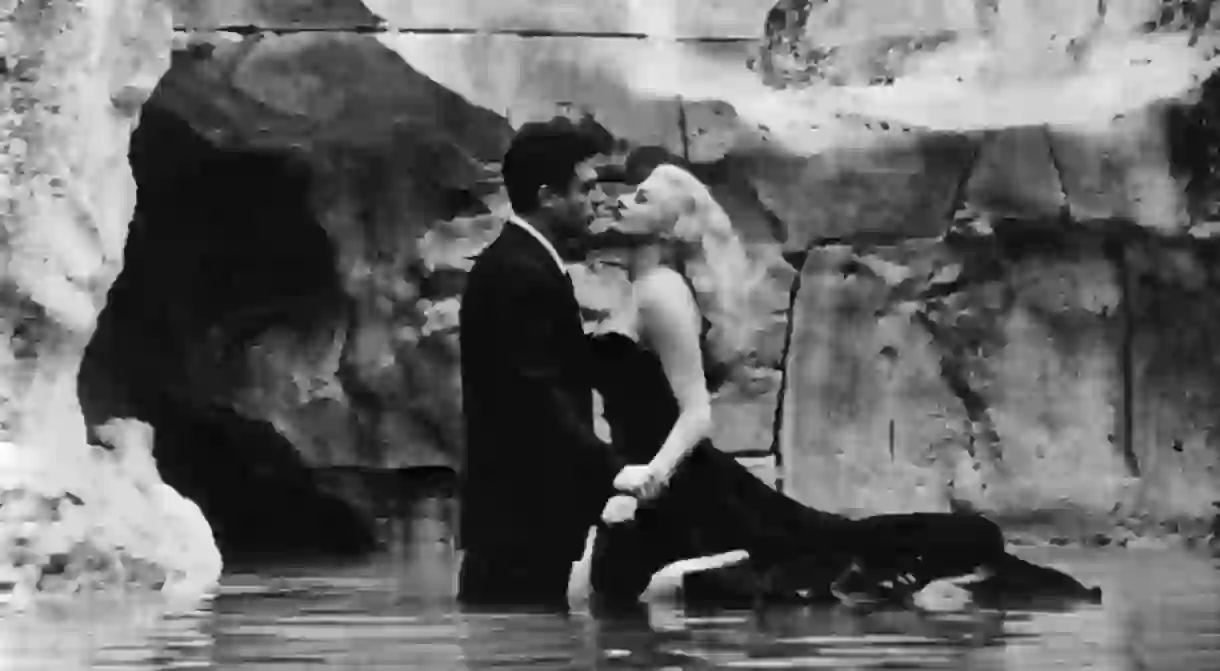Exploring Fellini’s Rome: A City Guide to the Director’s Favourite Film Locations

Celebrated film director Federico Fellini captured the true essence of the Italian capital. Rome’s beauty, raw energy and surrealist side are still visible in some of the director’s favourite haunts and spots in the Eternal City.

Federico Fellini was never really part of the post-war Neorealist crowd, but there is something deeply authentic about his depictions of the Italian capital. Beauty and brutality, the sound of urgent, gossipy chat bouncing off the centro storico walls and the juxtaposition of the ancient and modern suddenly appearing in heat-infused dreamscapes – these are all constant threads in everyday Roman life.
The majority of his most celebrated backdrops, such as the Trevi Fountain and even the Rome Metro, were recreated at the city’s fabled Cinecittà Studios. While you can visit the studios’ nearby museum and go on a guided tour with a set visit, Fellini’s Rome is still very much with us – enchanting and bedazzling as ever.
Via Veneto
Historical Landmark

Hollywood stars from the ’50s established a boozy playground along this stretch, handily positioned near the US Embassy. Away from home and with no studio agents or PRs to watch over them, big-screen names were left to kick back and carouse as much as they wanted. Before too long, Elizabeth Taylor, Kim Novak, Ava Gardner, Ingrid Bergman and the rest were being bothered by squads of freelance photographers, hopping between bars and hanging around nightclub doorways and hotel lobbies. Fellini famously used the scene as a starting point for La Dolce Vita’s (1960) exploration of the dark side of our celebrity obsessions. Strolling around today may prove something of a disappointment, but it’s enjoyed a mini-revival of late, and after a couple of sips of a Negroni, you can soon feel the ghosts of glam air-kissing and flitting around you. Appears in: La Dolce Vita
Trevi Fountain
Historical Landmark

A frantic tourist-selfie trap by day, this still-magical spot is best experienced in the wee small hours when the coach parties are long gone, and the piazza falls quiet – or quieter, at any rate. Since the Trevi Fountain is smack dab in the middle of the city, you’re highly unlikely to have it all to yourself, but you might find a moment to coo “Marceeeello…”. The Baroque backdrop dates back to the 1700s – it was constructed from travertine stone, quarried just outside the city. When Fellini’s leading man Marcello Mastroianni died in 1996, the fountain was turned off and draped in black in tribute; when his co-star Anita Ekberg followed him in 2015, the Rome authorities unfurled a huge canvas image of her looking down on the piazza, with the words “Ciao Anita”. Appears in: La Dolce Vita
Colosseum
Archaeological site

The Colosseum is another Roman landmark best experienced at night when it’s all lit up, and gangs of stray cats step out from the ancient limestone in search of food and a chin rub, blocking the way of unsuspecting evening strollers. Fellini, ever the cat lover, would feed them while filming Lo Sceicco Bianco (The White Sheik, 1952), with the Colosseum’s darkened corners providing the perfect cover for a variety of vices. These days you just need to watch out for those cats. Appears in: Lo Sceicco Bianco
Piazza del Popolo
Historical Landmark

Fregene
Natural Feature, Historical Landmark

Fellini loved this small seaside town, which is just outside Rome on the Tyrrhenian coast, and chose it as the setting for La Dolce Vita’s celebrated final scene. When he bought a villa here in the late 1950s, the sleepy gem became something of an arty retreat with actors, writers and musicians, many within the director’s circle, setting up summer homes here. Now massively popular with a new crowd of TV celebrities and sports stars, it lacks the glamour and slightly boho air of its post-war heyday, but it still has plenty of charm. Appears in: Lo Sceicco Bianco, La Dolce Vita, Giulietta degli Spiriti (Juliet of the Spirits, 1965)
EUR
Building, Historical Landmark

Baths of Caracalla
Archaeological site, Historical Landmark

Fellini converted these ancient thermal baths into a subterranean nightclub for a show-stopping scene in La Dolce Vita, with Anita Ekberg seductively dancing the Frug alongside a jazz combo. Set along the Appian Way, today the Baths of Caracalla regularly play host to live music and theatrical events but are worth a visit even if there’s nothing on. As it’s less busy than some of Rome’s other famous ruins, it’s a great place where you can escape the heat and get your historical groove on all at the same time. Appears in: La Dolce Vita
Basilica of Santa Maria degli Angeli e dei Martiri
Church

In November 1993, Fellini’s state funeral service took place in this basilica partly designed by Michelangelo, near the Piazza della Repubblica. Some 30,000 mourners had gathered earlier in the day at Cinecittà, with thousands waiting outside the church for a glimpse of his coffin. However, you won’t find his grave here – Fellini returned home to the Rimini Cemetery shortly after the service.
Grande Raccordo Anulare
Historical Landmark

The last place on this list of Fellini Roman locales is the colossal ring road that circles the city. Don’t spend more time than you need to stuck on this orbital motorway. However, if you find yourself in the back of a taxi gazing out across the concrete expanse for any length of time, remember that Fellini managed to find a certain magic even in this place, with white horses running between the banks of cars caught up in a very Felliniesque, very Roman traffic jam. Appears in: Roma (1972)













